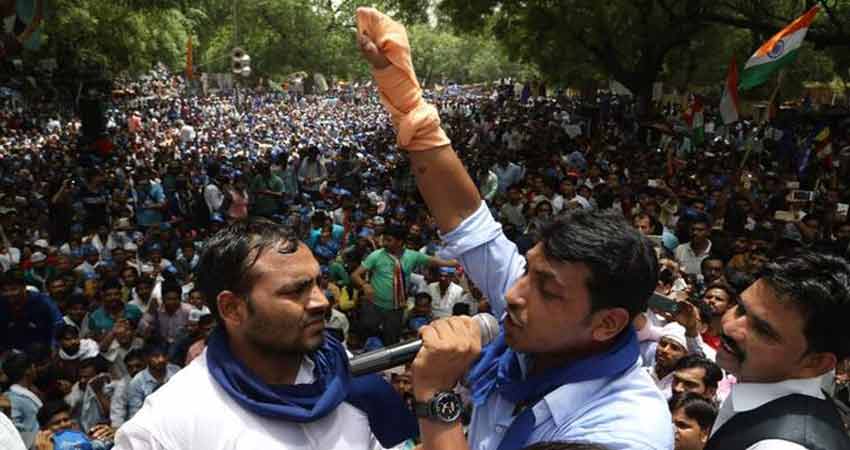The Allahabad High Court recently extended the incarceration of Bhim Army leader Chandrashekhar Ravan under NSA, by 3 months. Ravan will be held in jail now for at least till 2nd November. Chandrasekhar was arrested by the Yogi Government on charges of ‘rioting’ in the context of the violence that broke out in Saharanpur in UP (in May last year) when organised armed Rajput gangs attacked dalit households in Shabbirpur village of Saharanpur district, defiled the local Sant Ravidas temple, destroyed property, injured people, and set several houses on fire. Ravan was slapped with NSA a day after the High Court granted him bail on the general FIR that was filed against him. He was picked up from Dalhousie in neighboring Himachal Pradesh on 8th June 2017, and has remained in jail since.
The Bhim Army have given call for a protest meeting in New Delhi on 19th August, in protest of the continued incarceration of Chandrashekhar Azad Ravan, of people arrested during the Bharat Bandh on 2nd April this year in protest of the dilution of the SC/ST (Prevention of) Atrocities Act and organised attacks against dalits, and of those arrested in context of the Bhima Koregaon protests in Maharashtra.
Last month, GroundXero went and talked to Vinay Ratan Singh, one of the National Conveners of Bhim Army, to learn about the organisation and it’s activities, larger anti-caste politics in UP, and in particular the targeting of it’s members and leaders by the state apparatus.
gX: Tell us about the formation of Bhim Army.
VRS: My journey with Bhim Army started from this village, Fatehpur Mahadev, Chandrashekhar bhai used to live very close to this place. Some of us got together and thought we needed to do something about the existing conditions of our people in these areas, particularly when it comes to primary school education. We consulted our friends, and called for the founding meeting of Bhim Army right here in this village. Twelve of us attended that meeting on 21 July 2015, from various villages. Then we went from village to village, and more people kept joining us. For first few months we went around taking stock of the situation in all these villages.
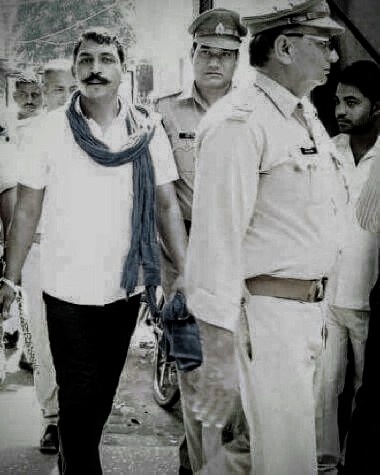
UP Special Task Force arrests Chandrashekhar Azad Ravan. June 2017. Photo: Internet
gX: So what was the situation like? What were your findings?
VRS: Various things. The primary school system is in shambles, mostly what you can find is meals being served to children, but no education. And it is our (dalit) children who have to depend on such schools. The upper caste children are mostly sent to expensive private schools. Then you have atrocities. The situation was such that people were scared to even go file a police to lodge complaint when there was an atrocity. The administration anyway is against filing of such cases. The poverty and lack of proper education that our people live with, makes it even harder for them to negotiate such structures.
So we started our own register of such incidents, and started assisting the victim families in getting justice. We would help them with writing petitions, applications, filing cases. But our main work was to open Bhim Army Pathshalas across villages. In these tution centers, in addition to helping the children with their regular school curriculum, we also started discussing the works and ideas of BR Ambedkar and other Dalit thinkers.
gX: How did the administration react to your work and involvement in these things?
VRS: Obviously they were not happy. For the first time in these parts, Dalits stopped begging them for justice or mercy. In a way, the atrocities rose up initially, and that showed the administrative response to such efforts. For instance, there was an issue in one of the schools here, when the Savarnas demanded that they should have the primary rights to drink water from one of the bore-wells in the school. We fought against that.
Dalit girls used to stop going to school after a point, because the schools would be typically 2-3 kms away from home, and they would often be attacked on the way. These girls restarted education after our Pathshalas came up. We also gave them contacts of Bhim Army people from nearby villages, in case they get attacked by anyone. This gave them confidence. We also ran blood donation camps. We have given blood to many people in emergency, regardless of their caste, etc. We were also doing other things, like telling people about road safety, etc.
gX: How would you go about opening and running the Pathshalas?
VRS: We conduct public meetings across villages. After every meeting we sit down with the educated youth – both men and women – from the village, who are keen on such initiatives. Then they would sign up and volunteer for such activities. The main thing is to gather children after the school hours, bring them to the Pathsalas and teach them for an hour or two every evening.
gX: Which kind of people usually teach in these schools?
VRS: See, our meetings typically happen in the Dalit community spaces in the village, so ultimately only dalits show up, and work for these Pathshalas. But there is nothing in our policy that prevents anyone who is interested in either teaching or enrolling in these schools, on a voluntary basis. There are many from the Bahujan and Muslim communities in our schools. In some villages, even Savarnas children have come enrolled in the Pathsalas..
Initially we started with around 150 schools. Now there are thousands, across almost all the districts of UP – Saharanpur, Muzaffarnagar, Shamli, Hardwar, Agra, Ghazipur. Even in Dehra Dun, in Uttarakhand, we are going to start now. We are opening schools in Maharashtra as well. We want Bhim Army Pathshalas to open across the country.
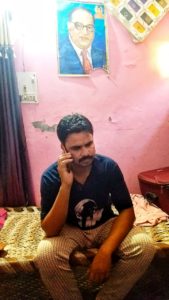
Vinay Ratan Singh, National Convener, Bhim Army
gX: Tell us a little about how Bhim Army approaches the task of critiquing mainstream education system for their narrative of history – what does the dominant narrative highlight and what does it hide…
VRS: Our first priority is to teach young children about Babasaheb (Dr. Bhimrao Ambedkar) and his struggle against the caste-system. We have seen that children relate to this quite quickly and organically. We have faced questions from them, such as “If Babasaheb took up such and such actions in those times, what kind of things should we do now in today’s times?” For the teachers, this has also meant that now we also have to study seriously to answer their questions.
gX: Tell us a little more about the kind of interactions you have had with the children…
VRS: Once for example, one small child around 3 years of age, his clothes tattered, mud all over his face, greeted me with ‘Jai Bhim’ as I walked into the Pathshala. I asked him, why do you say ‘Jai Bhim’. He immediately retorted, ‘you don’t know. There was a person called Babasaheb Bhimrao, who gave us the right to wear clothes and eat chicken’. (Smiles)
gX: What happens when these children get back to their classrooms in their formal schools?
VRS: Once, one of our children greeted his teacher in (a private) school with ‘Jai Bhim’. The teacher took offense and asked him “Why are you saying Jai Bhim?” (Here people typically use “Ram Ram”) The child came back to us and asked us. I told him to tell his teacher that Jai Bhim refers to that person who gave this country it’s Constitution. The teacher got further offended and asked the kid if he or his parents had ever read the Constitution. He came back and told me what his teacher told him, I told him to go tell his teacher that the Constitution is in our DNA (laughs). That child actually went and told his school teacher this, then that person called me, and told “This can not go on, Jai Bhim nahi chalega idhar”. I told him that if Jai Bhim can’t go on here, then neither can Jai Shri Ram, or As-salamu malaykum.
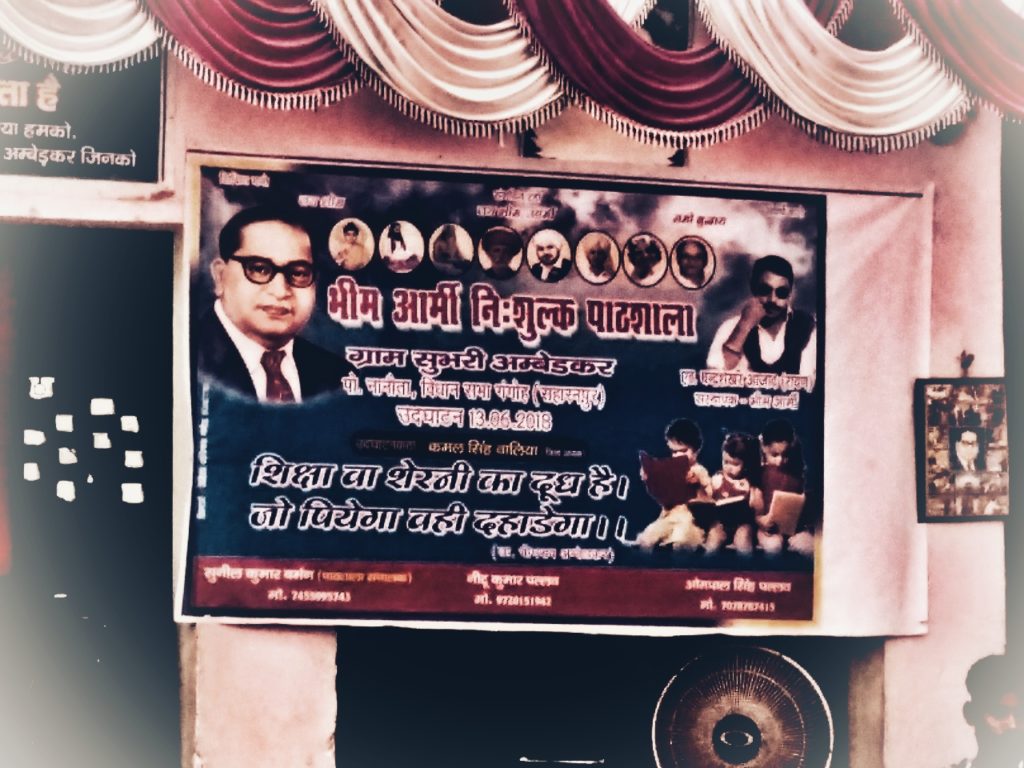
Opening of a new Bhim Army Pathshala in Saharanpur district. Photo: GroundXero
gX: Do you see active women participation in the Organisation?
VRS: Yes, however it is more difficult for women to go out and work in the movement the way men can do. This has mostly got to do with the fact that we are a poor people’s organisation, so it gets difficult for people generally, and women in particular, to travel to far away town-meetings and so on. But we have a (cadre-based) ‘chain system’, and people are put in charge of their respective villages. There are many women who are working in their own villages in such capacities.
Also when some campaign goes on, large numbers of women join. There have been significant presence of women in the Release Campaign for Shekhar Bhai (Chandrashekhar Azad Ravan), in the ‘jail bharo’ programs.
gX: Let’s talk about what happened in that phase, when Chandrashekhar Ravan was arrested.
VRS: An incident happened on 20th April 201, in a village called Dudhli (Saharanpur). The residents are mainly dalits (Ravidasis – worshipers of Saint Ravidas) and Muslims. This time we decided that on the 14th April Ambedkar Jayanti procession there would be inaugurated by the Muslim community. Accordingly, Dalits and Muslims together celebrated 14th April this time. We organised joint meetings, etc. After this, the Saharanpur BJP MP Raghav Lakhanpal Sharma announced that BJP will take out ‘it’s own’ Ambedkar procession in the area, on 20th April. First of all, Ambedkar Jayanti is 14th April, and not 20th April. Secondly, even when the police administration had clearly instructed the MP to not take his procession through ‘sensitive areas’, they violated the permitted route, and made sure that the procession passes through Dudhli. ‘Jai Shri Ram’ slogan was chanted in the procession, slogans such as ‘Is des me rehna hoga toh Raam Raam kehna hoga’, ‘Is des me rehna hoga toh Yogi Yogi kehna hoga’ were raised. Such inflammatory slogans and abuses surely enough, led to a clash between the people in the procession and the Muslim community in the areas they were passing through.
We conducted a press conference the next day, where we clearly mentioned that we (dalits) had no problems with the Muslims living in that area. In fact we had already organised our own Ambedkar Jayanti together. We also raised the question, the same people who had all these years refused to give us permission to take out Dr. Ambedkar’s processions, what changed suddenly that they felt so pressed to bring out their own Ambedkar Procession this year, and that too after Ambedkar Jayanti had actually passed? After this we were obviously branded as anti-Hindu and so on.
Another incident happened on the same 14th April, in Shabbirpur village. Dalits there had planned to install an Ambedkar statue inside their own Ravidas temple, but the local Rajput community raised objections. And immediately the local administration also issued a notice against installation of the statue. Then, on 5th May the Rajputs had their Maharana Pratap Jayanti. They took out their procession, passing through the dalit parts of the village, and raised “Ambedkar murdabaad” slogans. Soon, thousands of Rajput community members gathered, with swords and all, and set fire to the dalit households. Dalits were chased and beaten up, houses burnt down, their animals were killed. Meanwhile, we (Bhim Army) got to know about this …
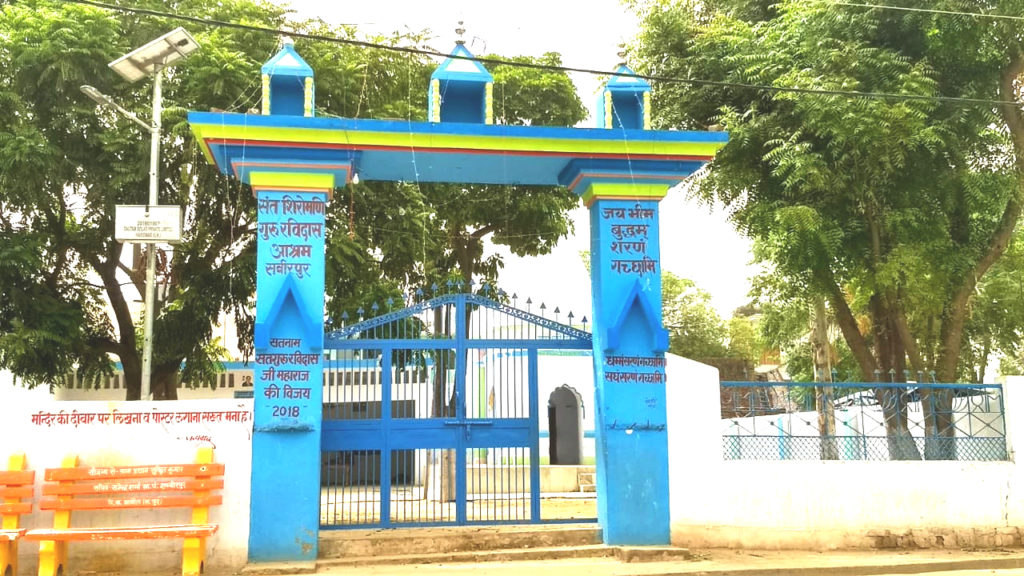
Photo: GroundXero
gX: Did the Bhim Army have a prior presence in Shabbirpur?
VRS: No, Bhim Army didn’t exist there then. Some of us tried reaching there on 5th May, but we were prevented by the administration. However, on 9th May, we announced a Maha Panchayat at Saharanpur town on this issue. But on 9th morning itself, heavy police force was deployed by the district administration, and as people started gathering for the Maha Panchayat, they began lathi- charge on the people. This was the tipping point for people, and they retaliated. Stone peltings etc. happened. Roads were blocked, vehicles were torched. We from Bhim Army gave public calls to the protesters to maintain peace and ensure that common people should not face inconvenience because of all this. In fact, the administration’s efforts to sabotage the meeting backfired. As news spread about the crackdown by the police, even those from villages who weren’t coming earlier poured on to the streets. Women came out in huge numbers.
Seeing that the situation is getting out of hand, the DM called up Shekhar Bhai, to help control the agitation. Shekhar Bhai responded immediately, and together with the DM, helped lift the road blockade at as many as eight places. He went and appealed in person to the particularly agitated gatherings, for peace.
Anyway, that evening onwards, the police started filing cases on people. Randomly, dalits were picked up and arrested. People were tortured in custody. Pressure was put on people to mention Chandrashekhar’s name as the ‘mastermind’ of the agitation. Prices were announced on the heads of Bhim Army organisers.
On 21st May we organised a huge protest rally in Delhi that was attended by tens of thousands. Finally on 8th June, Shekhar Bhai was arrested from Himachal. Many of us, including me courted arrest at that time. I was in jail for 5 weeks. Shekhar Bhai is still in jail, though the Government hasn’t been able to produce any evidence for his ‘involvement’ in any of this. The High Court in fact gave him bail, and described his arrest as ‘politically motivated’. But then they booked him under the National Security Act, though according to the lawyers there is absolutely no evidence on the basis of which he can be charged with something as grave as NSA.
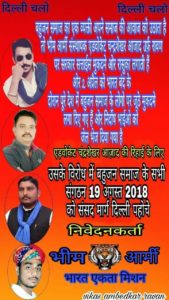
Call for Public Meeting at Sansad Marg, New Delhi on August 19, against the incarceration of anti-caste leaders, political workers, activists and protesters at large. Courtesy: Bhim Army
gX: Given that Bhim Army began mainly as a social reform movement, why did the Government feel so threatened by it?
VRS: Of course the Government is threatened by us. One thing is, in today’s times, the Government feels seriously threatened by the name and the ideas of Babasaheb Ambedkar. They feel threatened by people like Jyotiba Phule, Savitribai, Ashfaqullah Khan. But it particular, this area where you are in now, has for the longest time been a stronghold of the RSS. There is a high density of their Ekal Vidyalayas here. There is a huge number of RSS activists here – cutting across all social classes, including even Muslims. We even had a Muslim Go-Rakshak head here! So in that kind of a situation, when you seriously work towards loosening a grip of the Ekal Vidyalayas, by setting up Bhim Pathshalas, when you discuss annihilation of caste and criticize Brahmincal Hindu religion with a constituency of people who they always thought of as foot-soldiers for their communal agenda, why won’t they feel threatened? In a way we have attacked the breeding ground of Sangh’s politics.
gX: Could you talk about the Dalit-Muslim relations or dynamics…
VRS: See, in this part of the country, the history of ‘Hindu-Muslim’ direct clashes has been basically Dalit-Muslim clashes. Mainly because of lack of education and a failure to identify the common oppressor, these clashes get engineered by the powers that be. Our own people (from dalit communities) are also there in RSS.
Here for instance, on occasions such as Ramzaan or Eid, RSS would go and instigate clashes between dalits and muslims in various places. Ever since we became active, we have intervened in such situations. We must have prevented at least 100 such riots over the past couple of years. We have prevented riots in those places where riots have been a regular, annual, phenomenon. This instilled some faith in Muslim communities as well – they realised that we are genuine. As of now, there is a lot of solidarity between our communities and Muslim communities here. We are still being able to resist and voice ourselves, but the Muslims can’t even open their mouths. They will be immediately attacked and silenced.
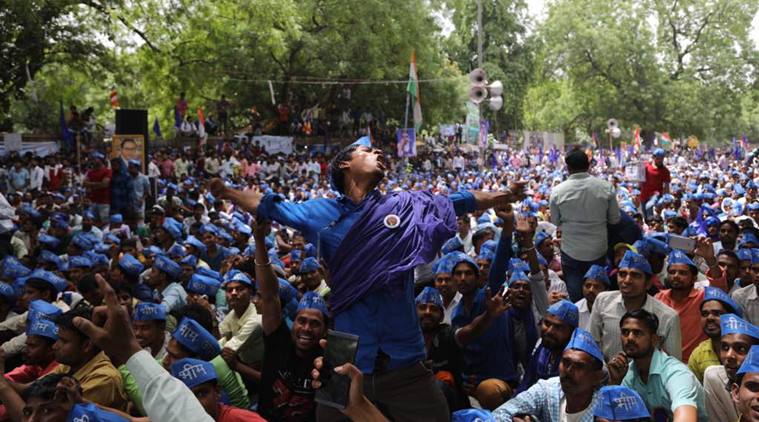
Bhim Army rally. Courtesy: Indian Express
gX : What about the economy of Saharanpur? Control over land, business, etc.
VRS : The town-economy here is completely in the hands of the Savarnas – Baniyas, Brahmans, Punjabis. In the villages, wherever dalits have access to land, there they are doing relatively better. However those parts where we don’t have any land and have to depend solely on wage labour, there the situation is very difficult. The fact that some proportion of dalit families own land in these parts of the state, definitely helps us fight back and sustain our fights. This is different from, say how it is in Muzaffarnagar, where our people are far worse off, with very little land.
gX: Does the presence of Muslim traders or local business also have an impact on the employability of dalits?
VRS: Of course. See, anyway, in any business, the chief workforce would be dalits. But earlier, in baniya shops for instance, we would get beaten up and humiliated, but still work. But now, we don’t take that kind of violence from the dominant castes. And if you have Muslim traders in your area, then you have safe working options. Muslim employers will even cook food and feed their dalit employees. Of course we would prefer to work with Muslim employers.
gX: But there are social hierarchies even among Muslim communities. So when you talk about these relations between dalits and muslims, how do those factors play out, if at all?
VRS: See, it’s simple. Both Hindus and Muslims have social hierarchies among them. And amid tensions, there are also social interactions between a Hindu caste group and a ‘parallel’ corresponding Muslim caste-group, like Hindu Gujjars and Muslim Gujjars, Hindu Rajputs and Muslim Rajputs, for example. This is because before people converted, these used to be the same castes. Now when caste-riots happen, the Hindu and Muslim upper castes often unite against the Dalits. But during communal riots, this ‘unity’ falls apart.
gX: What’s going to be your role in the 2019 elections?
VRS: We are going to put up stiff resistance to the Sangh and BJP, in 2019 elections, on the streets. Like we did in the Kairana elections, because of which the dalit communities there didn’t listen to any of those dalit leaders who were co-opted/coerced by Yogi, and voted for Tabassum. Both Bhim Army, and Advocate Chandrashekhar Azad Ravan ji personally had appealed to the people of Kairana to vote for the gathvandhan, against BJP. We think 2019 is going to turn out in a similar way, because most of the social classes are frustrated with these people (RSS-BJP).
gX: But does Bhim Army have any plans to contest in 2019?
VRS: See, organisations can build politics, politics can not build organisations. So our goal is to build an organisational presence, strong enough to create new politics. Our goal is to ensure, through our mass movement, that sincere and honest people get elected to responsible positions.

Photo courtesy: Esha Paul/The Quint
gX: In this country, resistance against Hindu fundamentalism seems to be coming mainly from two broad directions: from certain anti-caste movements, and from certain left movements. What is your opinion about critical engagements between these two kinds of movements. Do you see such a possibility or necessity at all?
VRS: The left forces or activists that I have worked with, I don’t see too much of a difference between their politics and ours. Both of us talk about emancipation, about a just society. Our ways of analysing society, or our ways of going about that struggle could have differences, but ultimately I think we have the same broad goal. Plus, right now we are faced with a powerful common enemy, and we must unite to defeat such forces. Otherwise in this country, I believe that Ambedkarites can not survive without the left, neither can the left survive without the Ambedkarites. And for the oppressor, both of us are his enemies. If they are allowed, they want to deal with all of us in the same way they dealt with Gauri Lankesh or Kalburgi. After they killed Gauri Lankesh, we organised candle light marches across 150 villages here. It shook the administration.
This is what we need to do. We need to fight for each other, across the country. If we do that sincerely, these people’s days are numbered.
GroundXero contacted Vinay Ratan Singh on the recent extension of jail custody for Advocate Chandrashekhar Azad Ravan. Vinay condemned this order vehemently, and described it as part of the general scheme of organised attack by manuvadi forces on dalit movement and it’s leadership. Bhim Army have called for a mass meeting at Sansad Marg, New Delhi, on 19th August, demanding immediate release of Advocate Chandrashekhar, of the people arrested in the context of the National Strike organised on 2nd April earlier this year against dilution of the SC/ST (Prevention of) Atrocities Act, and of the activists and other common people arrested in context of the Bhima Koregaon protests.

